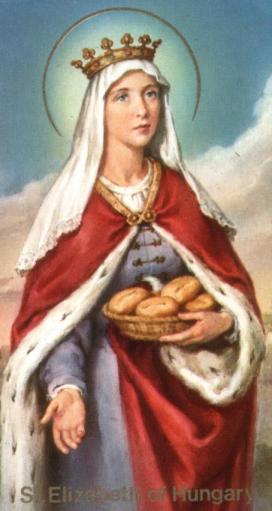Saint Elizabeth of Hungary

1207-1231
Also known as: Elizabeth of Thuringia or Elisabeth of Thuringia
Memorial: 19 November
Saint Elizabeth was a princess and born in Sarospatak, Hungary, in 1207 as the daughter of King Andrew II of Hungary and his wife Gertrude Countess of Andechs. At the age of four she was sent for education to the court of the Landgrave of Thuringia, to whose infant son she was betrothed. As she grew in age, her piety also increased by leaps and bounds. In 1221, only 14 years old, she married Ludwig IV; they had three children. The court of Thuringia was at this period famous for its magnificence. Its centre was the stately castle of the Wartburg, splendidly placed on a hill in the Thuringian Forest near Eisenach, where the Landgrave Hermann lived surrounded by poets and minnesingers, to whom he was a generous patron. Notwithstanding the turbulence and purely secular life of the court and the pomp of her surroundings, the little girl grew up a very religious child with an evident inclination to prayer and pious observances and small acts of self-mortification. These religious impulses were undoubtedly strengthened by the sorrowful experiences of her life.
Shortly after their marriage, Elizabeth and Ludwig made a journey to Hungary; Ludwig was often after this employed by the Emperor Frederick II, to whom he was much attached, in the affairs of the empire. In the spring of 1226, when floods, famine, and the pest wrought havoc in Thuringia, Ludwig was in Italy attending the Diet at Cremona on behalf of the emperor and the empire. Under these circumstances Elizabeth assumed control of affairs, distributed alms in all parts of the territory of her husband, giving even state robes and ornaments to the poor. In order to care personally for the unfortunate she built below the Wartburg a hospital with twenty-eight beds and visited the inmates daily to attend to their wants; at the same time she aided nine hundred poor daily. It is this period of her life that has preserved Elizabeth's fame to posterity as the gentle and charitable chételaine of the Wartburg. Ludwig on his return confirmed all she had done.
So great was her diligence for the poor, that the hour for meat had drawn near before she remembered the need of her presence at the castle. Then, lest she put shame upon Ludwig by keeping his guests waiting, she entered the hall as she was, clothed in her grey gown of service. But as she crossed the threshold angels descended from heaven bearing fitting raiment for her; one, a coronet for her head, one a dress of golden tissue, and one a mantle. So that when Elizabeth took her seat beside her consort she appeared in the sight of all who beheld her as fair as the lady of Heaven herself.
And greater than these is that tale of the leper that came, crawling to the castle, seeking help from Elizabeth. Ludwig was far distant; and the leper being far gone in his foul disease and all other places filled, Elizabeth carried him in her arms and laid him in Ludwig's own bed. When Sophie discovered this she was greatly enraged and dispatched a messenger for Ludwig; and upon his arrival at the castle at midnight, she conveyed him to his bed room, saying as they went: "A pretty wife thou hast. So little cloth she care for thee or thy love that she has placed in thy very bed a dying leper. This, that thou mayest take the scourge thyself."
When her pious young husband died in Sicily on his way to a Crusade with the Emperor Frederick, she was cruelly driven from her palace by her brother-in-law. Those whom she had aided showed nothing but coldness for her; God was to purify His Saint by harsh tribulations. She was forced to wander through the streets with her little children, a prey to hunger and cold. The bishop of Bamberg, her maternal uncle, finally forced the cruel prince to ask pardon for his ill treatment of her, but she voluntarily renounced the grandeurs of the world, and went to live in a small house she had prepared in the city of Marburgh. There she practiced the greatest austerities. She welcomed all her sufferings, and continued to be the mother of the poor, distributing all of the heritage eventually conceded to her, and converting many by her holy life. She had few more years of life to run, but she spent them in constant prayer and practical charity, and became universally loved and revered.
St Elizabeth is traditionally represented as dressed in rich clothes, bearing in her top skirt-which is gathered up at the front to form an apron-a profusion of red roses, while behind her back she holds a loaf of bread; these are the symbols of her life, her inherited position as Queen of Hungary, and the life she elected for herself of penance and asceticism. She died on November 19th, 1231. Shortly before her death at the age of 24, her son regained control of the government of Thuringia and summoned her back to court. Elizabeth was canonized in 1235 by Pope Gregory IX. The shrine of her remains in Marburg was a popular pilgrimage in the middle ages.
Very soon after the death of Elizabeth miracles began to be worked at her grave in the church of the hospital, especially miracles of healing. Master Conrad showed great zeal in advancing the process of canonization.
Patronage:
Bakers, beggars, brides, charitable societies, charitable workers, charities, countesses, death of children, exiles, falsely accused people, hoboes, homeless people, hospitals, in-law problems, lacemakers, lace workers, nursing homes, nursing services, people in exile, people ridiculed for their piety, Sisters of Mercy, tertiaries, Teutonic Knights, toothache, tramps, widows.
Prayer

Almighty God,
by Whose grace your servant Elizabeth of Hungary recognized and honored Jesus in the poor of this world:
Grant that we, following her example,
may with love and gladness serve those in any need or trouble, in the name and for the sake of Jesus Christ our Lord, who lives and reigns with you and the Holy Spirit, one God, now and forever.
Amen 
